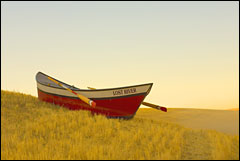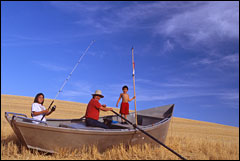
“The miracle meal after the Sermon on the Mount was both loaves and fishes,” says author and storyteller David James Duncan. “Not one or the other. Both.”
It’s a sentiment that helps to explain why Duncan and a variety of compatriots were photographed in 13 colorful dories, rowing and casting lines — into a golden field of wheat. The image appears on a poster distributed by Save Our Wild Salmon, a collaboration of conservationists, fisherfolk, and others interested in the removal of four dams on the Lower Snake River in Washington state.

Fisherfolk: Soon to be extinct too?
Photo: Steve Pettit
Since the dams were constructed between 1962 and 1981, 90 percent of the salmon in 5,500 miles of streams in Oregon, Washington, and Idaho have disappeared. Unless the dams are removed, says the 55-year-old Duncan, “My generation is the last generation of salmon and steelhead fishermen that there will ever be in the interior of Idaho and eastern Washington and eastern Oregon.”
Wheat farmers are some of the dams’ biggest proponents; the slack waters created by the dams make it possible for them to barge their grain to market relatively cheaply. So now the Snake River is plied by grain boats, while salmon are vacuumed up into trucks, driven around the series of dams, and then dropped back into the river in a weakened and disoriented state. “Leave the fish in the rivers and truck the grain,” some salmon advocates have argued. There’s an undeniable logic to the argument, and yet, perhaps inadvertently, it contributes to an atmosphere that pits farmers against fishers.

Nez Perce fisher James Walker with daughter Alana and son Teewis.
Photo: Steve Pettit
Save Our Wild Salmon has been trying to find common ground between these two groups, encouraging dialogue and seeking creative ideas for alternative transportation systems if the dams were to be taken down. “We must do a better job of listening to the concerns of wheat growers and others,” says Sam Mace, the group’s project director for the inland Northwest. “At the same time, we hope that agricultural interests will consider the hardships facing commercial, sport, and tribal fishing families and businesses affected by the loss of Snake River salmon and steelhead.”
When Duncan hatched the idea of photographing fishing boats in a “river” of wheat, wanting to illustrate connections between two iconic livelihoods in the Northwest, Save Our Wild Salmon leapt on board — literally.
GET THE POSTER
Get a copy of the “Lost River” poster by making a donation to Save Our Wild Salmon.
Forging viable solutions to the salmon crisis in the Snake River will be an upstream battle, so to speak — plenty of powerful interests are committed to maintaining the status quo. But Duncan is motivated to keep rowing forward.
“You watch salmon and it doesn’t matter what bars their way — they still try to return to their home waters,” he says. “I feel like I’ve taken that, whatever it is, that Coho spirit … that’s my inspiration.”

